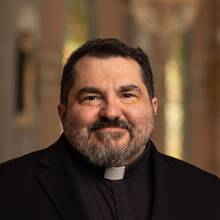The Presence
The Hebrew Bible answers the question, “Where is God?” in two ways. One answer is that “God is somewhere else.” Another answer is that “God is here with us.” In the opening chapters of Genesis, for example, God is both the cosmic creator who transcends the heavens and the master gardener who works the earth with his own hands. In Exodus and Numbers, Moses finds God in the solitude of the mysterious cloud, but every Israelite also saw God in the fiery glory at the center of the Israelite camp. David and his successors found God in springtime thunderstorms, refulgent with power and light, coming mysteriously down from the heavens, filling the earth with life and then departing just as suddenly. They just as easily found God’s presence in the Jerusalem Temple, where anyone who wished could come and pray. It took many centuries, but Israel learned that God was both “there” and “here” or, as scholars say, both “transcendent” and “immanent.”
‘It is something very near to you, in your mouth and in your heart, to do it.’ (Dt 30:14)
How has Christ empowered your love?
How has loving others shown you Christ’s presence?
This is part of Israel’s religious genius. A god who is only immanent can become very small, a god of favorites, cliques and petty issues. “God-with-us” can too easily become “god-not-with-you.” A solely transcendent deity, on the other hand, can appear cosmically vast, remote, indifferent and ineffective. Instead, Israel came to believe that the God who established a treasured people also had a loving interest in the entire universe.
Jesus inherits Israel’s brilliance. He does not hesitate to pray to his transcendent Father “in heaven,” but he also believes in a Father who is very near. In today’s Gospel he teaches his disciples how to recognize that same presence.
God-with-us draws us forth to seek out God’s presence over the unknown horizon, to offer Christ’s message to every land, people and nation.
“On that day you will realize that I am in my Father and you are in me and I in you.” Throughout his Gospel, John insists on the strong relationship between Jesus’ commandments and the Father’s presence. Jesus commanded us to do only what he himself learned from his Father: to lay down his life for his friends. He obeyed the Father out of love; that self-sacrificial love meant that the Father was present with Jesus even after death. It was this presence that gave Jesus victory over death, and this presence that Jesus promises any of his disciples who similarly obey the Father’s commandment to love.
This divine presence is the Advocate and Spirit of truth of today’s Gospel. This is the presence that has protected and supported believers in every age. This intimate presence of God is also the force that has turned our attention outward to the world. This is the way Christ’s followers address the tension of immanence and transcendence: God-with-us draws us forth to seek out God’s presence over the unknown horizon, to offer Christ’s message to every land, people and nation.
This article also appeared in print, under the headline “The Presence,” in the May 15, 2017, issue.








